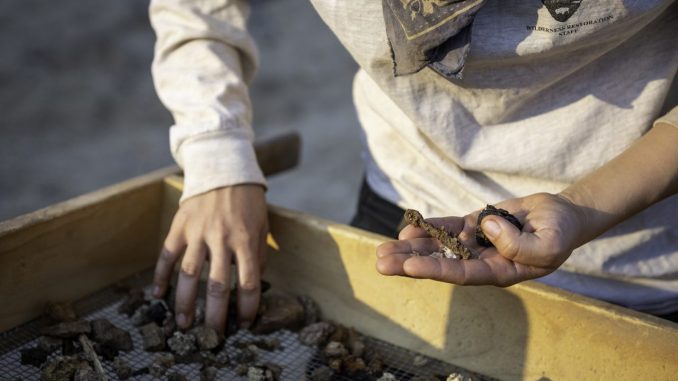
A lecture from SUNY New Paltz archaeology professor Joseph Diamond, an event sponsored by the New Paltz Historical Society, took place on Nov. 25 at the Elting Library. Diamond told the story of the Pine Street. African Burial Grounds in Kingston, land that was used as a graveyard for enslaved and free people of African descent from 1750 to the mid-1800s. In 1853, the burial ground land was bought, years after emancipation legislation passed in New York State. With new ownership, structures were built on top of the land, including a lumberyard and later houses in the growing city of Kingston. The headstones were relocated, but the bodies were not. In 2019, local organizations Harambee and the Kingston Land Trust purchased the land of the Pine Street African Burial Grounds, but much more exploration has occurred after that.
Diamond showed the audience maps of Kingston showing the Pine Street graveyard land dating back to the 1600s up to today and his experience excavating and preserving findings in the cemetery. This project has been ongoing since 1990 and continues today. Diamond explained the efforts he exerted to explore in summer 2024. The main goal was to determine the extent of the burial grounds and find the northern and western borders. Using Ground Penetrating Radar (GPR) technology, trowels, shovels and human strength to dig into the earth and get a three-dimensional picture of what was going on underground, he gave a summary of the results of the 2024 season. GPR technology can reach 10 meters beneath the ground and uses scattered electromagnetic waves to locate objects.
Diamond told the story of how he initially became tied to the excavation of the Pine Street African Burial Grounds, explaining how he found a map of Kingston from the 1870s and tried to locate the land that was once the cemetery. In 1990, Diamond came across a Pine Street homeowner who had found human bone chips under his property when fixing his water lines. Upon testing the bones, Diamond found that they were of African ancestry. Professor Ken Nystrom, chair of the anthropology department at SUNY New Paltz, helped lead the digging alongside Diamond. Diamond had a group of 25 students in field school last summer, and he and his team spent the summer in the hot sun, digging deep enough underground that they needed ladders to ascend to ground level. They started at 6:30 a.m. and worked until 2 p.m. digging and taking notes on findings. Student Jaison Castilo conducted field work at the Pine Street. Burial Grounds this past summer. He reflects on a “great experience for an archaeology major” that “helped connect [him] with others.”
The goal was to find out who the buried were, taking DNA samples and isotopic analysis to understand more about their backgrounds and gathering insight into enslaved people in Ulster County. DNA can also help find the descendants of the deceased. They uncovered artifacts, and remains continue to be investigated. Everything is repairable and historically revealing. When digging, a wooden box time capsule was found containing artifacts dated to the 1870s, including a bottle of cod liver oil soda dated back to 1868. When bodies were discovered on land that is now owned by the Kingston Land Trust and Harambee, they were offered respects and disinterred for burial on that property.
When a body was uncovered, the team took samples of the teeth and bones, which were organized thoroughly for further investigation in the near future. After gathering information and preserving what was found, the team covered the remains with African cloth and rose petals to be prepared for a ceremony honoring the dead, named or unnamed. While many of the buried remain unknown, they are not forgotten by Diamond nor his archaeological team. Although many names have not been discovered, one with the name Caezar Smith appeared visible on a buried engraved headstone. He was born into enslavement and died a free man at 41 years old. Some stories of people potentially buried in the Pine Street. African Burial Grounds were disturbing, including that of a person who was publicly tortured, whipped and hanged after being convicted of a crime.
Diamond is unsure whether he is going back to the Pine Street Burial Grounds location for another summer. Kingston organization Harambee intends to raise money to create a respectful resting spot for the buried and plans to transform the space into one that honors their African heritage. An important initiative, the Ulster County Truth and Reconciliation Commission has been established as a formal commitment to understanding the modern relevance of slavery in Ulster County and honoring the lives of enslaved and free Africans and African-Americans who have not been known until recently.
Diamond’s lecture enthralled the people at Elting Library with his stories and impressive knowledge and passion for archaeology. It left the attendees thinking about how the Pine Street. Burial Grounds tell the story of enslavement in the United States. What other buried truths can be uncovered about the past? Efforts like Diamond’s to uncover and preserve historical artifacts will tell this. Diamond will be releasing a new book describing the archaeology of Kingston, aptly titled “Archaeology of Kingston, New York.” His 2006 release “Owned in Life, Owned in Death” also discusses the Pine Street African Burial Grounds and his efforts to preserve the site.
